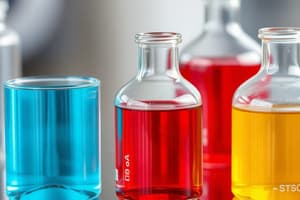Podcast
Questions and Answers
What is a characteristic of a chemical property?
What is a characteristic of a chemical property?
- Can be observed without changing the substance
- Is always visible to the naked eye
- Describes how a substance can change into a different substance (correct)
- Describes the physical appearance of a substance
Which of the following is NOT a sign of a chemical change?
Which of the following is NOT a sign of a chemical change?
- A new color appears
- Bubbles of gas form when heated (correct)
- A precipitate forms
- Heat and light are given off
Which example indicates a substance that is flammable?
Which example indicates a substance that is flammable?
- Acids do not react with metals
- Gasoline does not burn
- Wood catches fire easily (correct)
- Iron reacts with air to form rust
Which of the following changes indicates the production of a new substance?
Which of the following changes indicates the production of a new substance?
Why do we utilize the chemical properties of substances in production?
Why do we utilize the chemical properties of substances in production?
What observation would suggest that a chemical change has occurred?
What observation would suggest that a chemical change has occurred?
Which of the following statements about rust is true?
Which of the following statements about rust is true?
What is the likely outcome when bacteria turn milk into cheese?
What is the likely outcome when bacteria turn milk into cheese?
What type of change occurs when copper (II) sulfate dissolves in water?
What type of change occurs when copper (II) sulfate dissolves in water?
Which observation indicates a chemical change when iron is placed in a copper (II) sulfate solution?
Which observation indicates a chemical change when iron is placed in a copper (II) sulfate solution?
What evidence indicates that the interaction between lead nitrate and potassium iodide is a chemical change?
What evidence indicates that the interaction between lead nitrate and potassium iodide is a chemical change?
What occurs when neon gas in a tube is exposed to electricity?
What occurs when neon gas in a tube is exposed to electricity?
What happens to magnesium when it reacts with hydrochloric acid?
What happens to magnesium when it reacts with hydrochloric acid?
Which of the following substances illustrates a physical change during its reaction process?
Which of the following substances illustrates a physical change during its reaction process?
What is the outcome of boiling water in terms of chemical or physical change?
What is the outcome of boiling water in terms of chemical or physical change?
Which of the following processes does NOT result in a chemical change?
Which of the following processes does NOT result in a chemical change?
Flashcards
Chemical Property
Chemical Property
A characteristic of a substance that describes its ability to change its composition and form one or more new substances.
Examples of Chemical Properties
Examples of Chemical Properties
Flammability, combustibility, corrosiveness, reactivity with acids, rusting.
What's the purpose of chemical properties?
What's the purpose of chemical properties?
We use chemical properties to create products we need.
How do you know a chemical change has occurred?
How do you know a chemical change has occurred?
Signup and view all the flashcards
Signs of Chemical Change
Signs of Chemical Change
Signup and view all the flashcards
What's a precipitate?
What's a precipitate?
Signup and view all the flashcards
Can physical changes also have some of the signs of chemical change?
Can physical changes also have some of the signs of chemical change?
Signup and view all the flashcards
How to distinguish between chemical and physical change
How to distinguish between chemical and physical change
Signup and view all the flashcards
Physical Change
Physical Change
Signup and view all the flashcards
Chemical Change
Chemical Change
Signup and view all the flashcards
Evidence of a Chemical Change
Evidence of a Chemical Change
Signup and view all the flashcards
Copper Sulfate Dissolving
Copper Sulfate Dissolving
Signup and view all the flashcards
Iron and Copper Sulfate Reaction
Iron and Copper Sulfate Reaction
Signup and view all the flashcards
Lead Nitrate and Potassium Iodide
Lead Nitrate and Potassium Iodide
Signup and view all the flashcards
Neon Gas and Electricity
Neon Gas and Electricity
Signup and view all the flashcards
Magnesium and Hydrochloric Acid
Magnesium and Hydrochloric Acid
Signup and view all the flashcards
Study Notes
Chemical Properties and Change
- A chemical property describes a substance's ability to undergo changes in its composition to form new substances.
- Examples include flammability (wood), combustibility (gasoline), corrosiveness (acids), and reactions with acids (certain metals) or rusting (iron).
Physical Properties Activity
- The activity involved identifying physical properties (color, viscosity, clarity, texture, smell, luster, malleability, and ductility) of various substances (like glycerol, sulfur, carbon, copper wire, sugar, pancake mix, dish soap, mouthwash, wax).
- Each object was identified by its physical properties.
Chemical Properties and Chemical Change
- Image showing a fried egg, suggesting chemical changes occur when interacting with heat.
- Image showing a fire and a photo of a wooded area, indicating a chemical change due to combustion.
Types of Chemical Changes
- A new color appearing, heat or light given off, bubbles of gas forming (e.g., when not heated), formation of a precipitate (a solid from mixing liquids), and difficulty reversing the change are all signs of a chemical change.
Demonstrations (Demos)
- Demonstrations involved different substances (copper sulfate, lead nitrate, potassium iodide, neon gas, magnesium metal, hydrochloric acid) and observations like color changes, formation of solids (precipitates), and the production of gases.
- These activities helped in determining whether changes were physical or chemical.
- Evidence for chemical changes included color change, formation of new substances, evolution of gas (formation of bubbles) and difficulty reversing changes.
Homework
- Students were assigned homework, including questions from page 186, #1, 3, 4, 6, and 7.
Fun Facts
- 10 fun facts, including observations on things like the impossibility of washing eyes with soap, breathing through the nose with the tongue out.
Studying That Suits You
Use AI to generate personalized quizzes and flashcards to suit your learning preferences.




